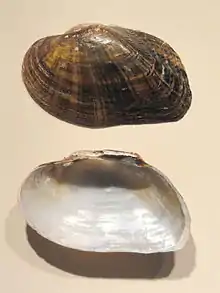Brook floater
The brook floater[2] or swollen wedgemussel,[3] Alasmidonta varicosa, is a species of freshwater mussel, an aquatic bivalve mollusk in the family Unionidae, the river mussels. It measures 25.1 mm to 80.2 mm in length[4] although other research also suggests it rarely exceeds three inches (75 mm).[2]
| Brook floater | |
|---|---|
 | |
| Scientific classification | |
| Domain: | Eukaryota |
| Kingdom: | Animalia |
| Phylum: | Mollusca |
| Class: | Bivalvia |
| Order: | Unionida |
| Family: | Unionidae |
| Genus: | Alasmidonta |
| Species: | A. varicosa |
| Binomial name | |
| Alasmidonta varicosa (Lamarck, 1819) | |
| Synonyms | |
|
Alismodonta varicosa (Lamarck, 1819) | |
Distribution
This species is found in Canada (New Brunswick and Nova Scotia)[5] and northeastern United States (Connecticut, Georgia, Maine, Maryland, Massachusetts, New Hampshire, New Jersey, New York, North Carolina, Pennsylvania, South Carolina, Vermont, Virginia and West Virginia);[6] It was formerly found in Rhode Island and four watersheds in Massachusetts but are now extinct in Rhode Island and almost extinct in Massachusetts.[2] 1897 Research by Arnold Edward Ortmann showed it to be common in the Delaware and Susquehanna Rivers.[7]
Habitat and behavior
This mussel lives in high relief streams, under boulders and in sand. Research has shown that it is highly sensitive to increased thermal temperature.[8] It associates with longnose and eastern blacknose dace, golden shiner, pumpkinseed, slimy sculpin and yellow perch.[9]
Survival threats and conservation
The brook floater is sensitive to habitat loss for development, dams and road crossings, pollution, summer droughts, trampling, sedimentation, flow alteration, and low oxygen conditions. Hybridization with elktoe (Alasmidonta marginata), a longtime ally, has also shown to be a threat.[10] Research has also shown the population is highly fragmented, low in density, prone to mortality due to old age and there are also low chances of longevity and viable reproduction.[2] Trematoda rhopalocercous cercaria is a parasite of the brook floater.[11] Current research shows population that were largely and widespread known declined by 50% to 95% to almost extinct.[12]
While the IUCN lists it as Vulnerable, the states of New Jersey, Virginia, Massachusetts and New Hampshire[2] all list it as Endangered,[13] Threatened in Vermont, Maine and New York,[14] Rare/Endangered in Connecticut,[9] Extinct in Rhode Island and "Species of Special Concern" by the federal government.[15]
References
- Woolnough, D.; Bogan, A.E. (2017). "Alasmidonta varicosa". IUCN Red List of Threatened Species. 2017: e.T781A69490583. doi:10.2305/IUCN.UK.2017-3.RLTS.T781A69490583.en. Retrieved 17 November 2021.
- Nedeau, Ethan (1 November 2009) [Originally published as "Brook Floater Fact Sheet" in December 2007]. "Brook Floater" (PDF). mass.gov. Archived from the original (PDF) on 21 September 2017.
- MassWildlife's Natural Heritage & Endangered Species Program (28 February 2020). "News Species Spotlight: Brook floater". Division of Fisheries and Wildlife. Commonwealth of Massachusetts. Retrieved 7 August 2023.
- Janet L. Clayton, Craig W. Stihler and Jack L. Wallace (2001). "Status of and Potential Impacts to the Freshwater Bivalves (Unionidae) in Patterson Creek, West Virginia". Northeastern Naturalist. 8 (2): 179–188. doi:10.1656/1092-6194(2001)008[0179:SOAPIT]2.0.CO;2.
- Caroline Caissie, Dominique Audet, Freshwater Mussel Inventory in the Shediac and Scoudouc Rivers Archived 2015-06-24 at the Wayback Machine, New Brunswick Wildlife Trust Fund, 2006, p. 12. Accessed August 21, 2014
- "Brook floater (Alasmidonta varicosa)". ecos.fws.gov. Retrieved June 23, 2015.
- Arnold Edward Ortmann (1897). Collected papers, Volume 1. self-published. Retrieved June 23, 2015.
- "Thermal History Impacts Thermal Tolerance of Freshwater Mussels". co2science.org. Retrieved June 23, 2015.
- Hammerson, Geoffrey A. (2004). Connecticut Wildlife: Biodiversity, Natural History, and Conservation. University Press of New England. p. 205. ISBN 978-1584653691. Retrieved June 23, 2015.
- Strayer, David L.; Fetterman, Andrew R. (1999). "Changes in the Distribution of Freshwater Mussels (Unionidae) in the Upper Susquehanna River Basin, 1955–1965 to 1996–1997". The American Midland Naturalist. 142 (2): 328. doi:10.1674/0003-0031(1999)142[0328:CITDOF]2.0.CO;2.
- Fischthal, Jacob H. (1954). "Cercaria tiogae Fischthal, 1953, a Rhopalocercous Form from the Clam, Alasmidonta varicosa (Lamarck)". Transactions of the American Microscopical Society. 73 (2): 210–215. doi:10.2307/3223759. JSTOR 3223759.
- "The conservation status of the brook floater mussel, Alasmidonta varicosa, in the Northeastern United States: trends in distribution, occurrence, and condition of populations". rcngrants.org. Retrieved June 23, 2015.
- Thomas F. Nalepa, Don W. Schloesser (2013). Quagga and Zebra Mussels: Biology, Impacts, and Control, Second Edition. CRC Press. p. 206. ISBN 978-1439854372. Retrieved June 23, 2015.
- McBroom, Matthew (2013). The Effects of Induced Hydraulic Fracturing on the Environment: Commercial Demands vs. Water, Wildlife, and Human Ecosystems. CRC Press. p. 285. ISBN 978-1926895833. Retrieved June 23, 2015.
- Bruce E. Beans, Larry Niles (2003). Endangered and Threatened Wildlife of New Jersey. Rutgers University Press. p. 257. ISBN 978-0813532097. Retrieved June 23, 2015.
